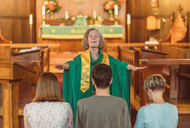Unveiling Women's Roles in the Church through Clergy Attire
Oct 9th 2023
The roles and positions of women within religious institutions have evolved over time, reflecting shifting societal norms and changing interpretations of religious texts. One intriguing aspect that provides insight into the roles of women in the church is the attire worn by female clergy members.
These garments, including Ladies class A vestments, not only carry symbolic significance but also shed light on the roles that women hold within the religious hierarchy. Let’s explore how the roles of women in the church are revealed through their clergy clothes.
Historical Context of Women in the Church
The role of women in the church has been a topic of both controversy and progress. One way to understand these roles is by analyzing the attire worn by female clergy members. Their clothing choices carry not only personal expression but also communicate their place within the religious community.
Throughout history, women's roles within the church have been restricted in many denominations. They were often limited to supportive roles and were excluded from leadership positions. However, as societies evolved, so did the roles of women within religious institutions.
Symbolism and Significance of Clergy Attire
Clergy attire, including robes, stoles, and Ladies class A vestments, is deeply symbolic. These garments often signify spiritual authority, devotion, and humility. For women in clergy, these symbols are particularly important, as they signal their acceptance of leadership roles and dedication to their faith.
Variety in Clergy Attire
Different denominations and traditions have varying styles of clergy attire. From the traditional robes of the Roman Catholic Church to the more casual attire of some Protestant denominations, these choices reflect the diversity of roles women hold within the church.
Clergy Attire as a Reflection of Roles
The type of clergy attire a woman chooses can reveal her role within the church. For instance, a woman wearing a clerical collar may indicate that she holds a pastoral or ministerial role, while a bishop's mitre or a Ladies’ class A vestments may signify a higher leadership position.
Breaking Traditional Norms
In recent decades, there has been a growing movement to challenge traditional gender roles within religious institutions. Many women in clergy now choose attire that defies traditional norms, allowing them to express their individuality while still fulfilling their roles as spiritual leaders.
Modern Interpretations
Modern interpretations of women's roles in the church emphasize equality and empowerment. As a result, clergy attire has evolved to reflect these values, with many women opting for clothing and ladies’ vestments that balance tradition with contemporary ideals.
Modern interpretations of women's clergy wear blend tradition and inclusivity. Tailored vestments reflect diverse roles and denominations. Design and comfort align with contemporary needs. Personal touches or accessories add unique symbolism, which redefine women's roles, promoting equality and recognizing their significant contributions in religious leadership.
Case Studies: Women's Clergy Attire in Different Denominations
Case Study 1: Roman Catholic Church
In the Roman Catholic Church, women religious often wear habits that reflect their orders. Some orders have retained traditional habits, while others have adopted more contemporary attire.
Case Study 2: Anglican Communion
The Anglican Communion encompasses a range of practices. Women within this denomination can be seen wearing everything from traditional robes to modern clothing, depending on their individual beliefs and roles.
Case Study 3: Protestant Churches
Protestant churches exhibit significant diversity in clergy attire. Some women choose robes, while others opt for business attire. This diversity reflects the variety of roles women hold within these congregations.
Empowerment and Identity
Clergy attire allows women to assert their identities as spiritual leaders. Choosing attire that resonates with their personal style and beliefs helps clergy women to present a holistic representation of themselves.
Modern interpretations of traditional vestments reflect inclusivity and recognition of women's roles in religious leadership. The fit and comfort acknowledge practicality while maintaining dignity and traditional customs.
Variations in color and style signify denominational affiliation and individual expression. Accessorizing with stoles, pendants, or collars adds personal symbolism. This fosters a sense of empowerment by allowing women to embrace their spiritual calling while affirming their unique identity, creating a visual representation of their vital role in guiding and nurturing their congregation.
Beyond Attire: Advocacy and Leadership
While clergy attire is a visual representation of women's roles, their impact goes beyond clothing. Clergy women are advocating for social justice, leading congregations, and making meaningful contributions to their communities.
Women advocate for equal roles in ministry, breaking barriers in pastoral, administrative, and teaching positions. Their leadership empowers diverse congregations, emphasizing inclusivity, social justice, and community engagement. Efforts range from grassroots initiatives to institutional changes, highlighting women's theological contributions and pastoral skills.
This fosters dialogue, transforming church culture to recognize and appreciate women's vital role, enriching the spiritual experience and promoting greater gender equality within religious institutions.
Clergy attire serves as a fascinating lens through which to examine the roles of women in the church. As women continue to challenge traditional norms and take on leadership positions, their attire reflects not only their dedication to faith but also their determination to reshape the narrative of women's roles within religious institutions.
